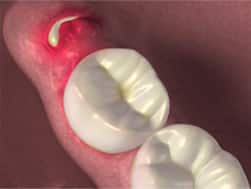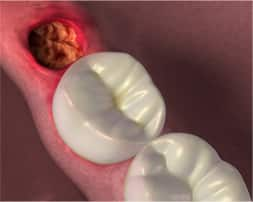 Crowded and impacted wisdom tooth.
Crowded and impacted wisdom tooth.
Wisdom teeth, or third molars, are extracted more often than any other teeth. Some people naturally have enough room in their mouths to accommodate the eruption of wisdom teeth. Those who do not have room for additional teeth may suffer impacted wisdom teeth, a condition in which the teeth remain buried below the gums or erupt out of line with the rest of the teeth. Wisdom teeth impacted below the gum line may cause pain, swelling and crowd or forcibly move other teeth.
When wisdom – or any teeth – are extracted, several complications may occur after surgery, including:
- Infection
- Nerve damage causing numbness of the lower lip or tongue
- Jaw stiffness
- Dry sockets
 Dry socket after wisdom tooth extraction.
Dry socket after wisdom tooth extraction.
What is a Dry Socket?
After extraction, a blood clot forms in the tooth socket, the space that once held the tooth, and seals the area so that it can heal. A dry socket occurs when the blood clot breaks down or is dislodged, exposing the bone and nerves. The first five or so days after extraction are the most critical, and it is during this time that the risk for a dry socket is the highest. A dry socket can be very painful! If you think you have this condition, contact your dentist immediately.
Treatment
Typically, your dentist will rinse out the empty socket, remove any debris and apply medicated dressings to protect the area and decrease pain. The dentist may also prescribe an antibiotic to prevent infection and a painkiller to ease discomfort. The dentist can advise you what to eat or drink as well as how to clean and care for the dry socket area. With proper care and rest, the dry socket should heal in seven to 10 days. Your dentist will probably ask that you schedule a follow up appointment to monitor healing and to see how you are doing.
© Copyright 2010 Colgate-Palmolive Company






